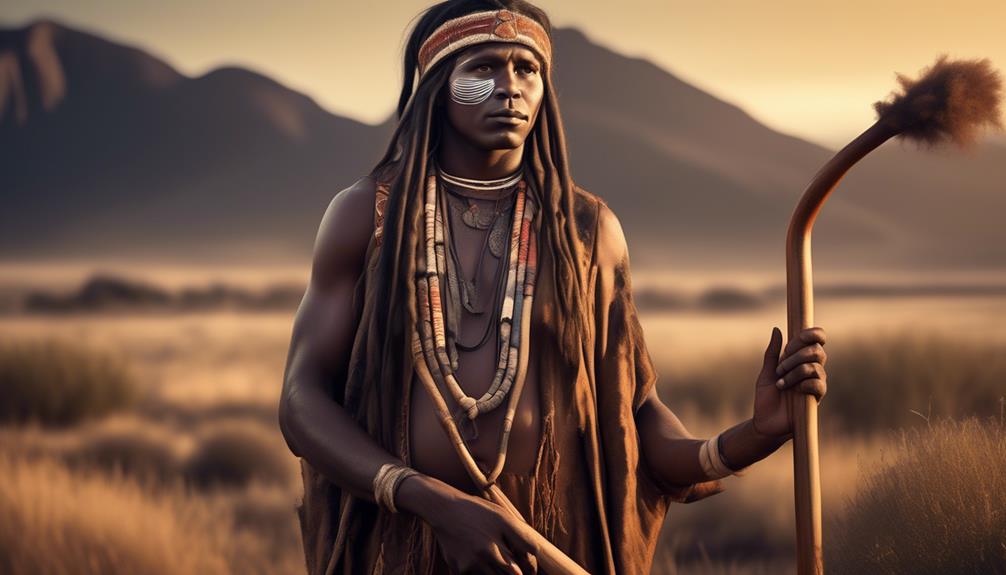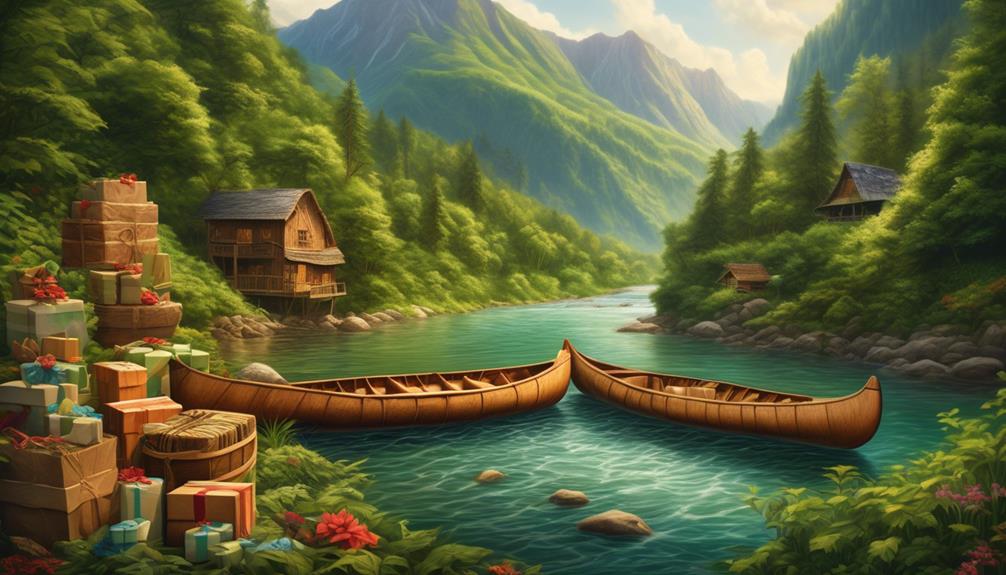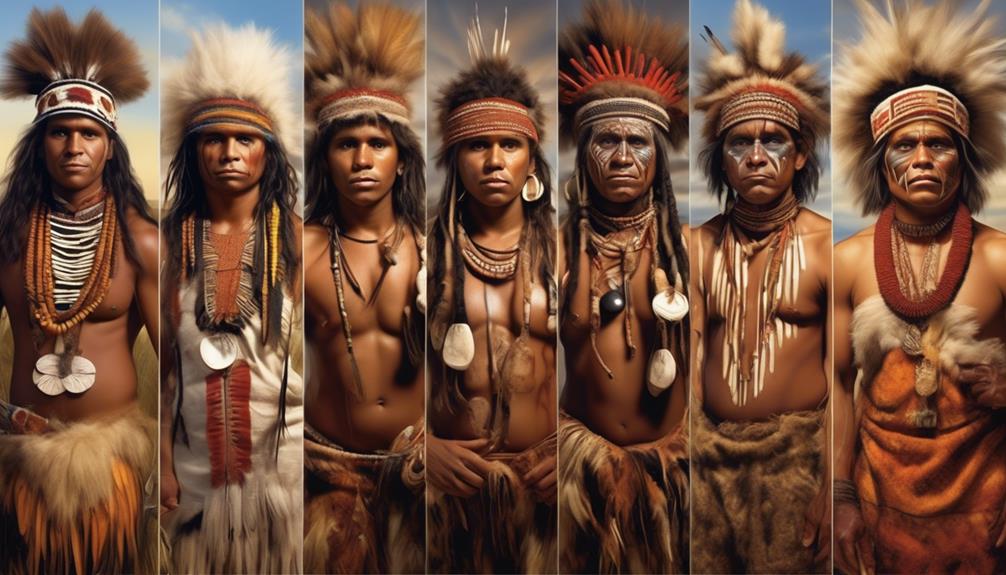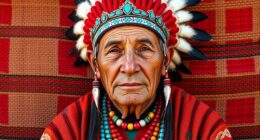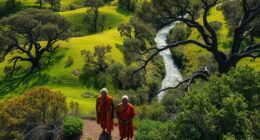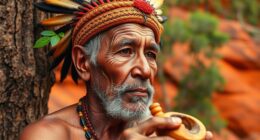Many may mistakenly believe that boomerangs were only used for leisure by Aboriginal men. However, these indigenous Australian tools actually had a multitude of practical and cultural uses that may surprise you. Boomerangs played vital roles in hunting, warfare, and ceremonial rituals, underscoring their significance in the lives of Aboriginal men.
The ways in which they utilized these curved throwing sticks were diverse and often deeply embedded in their cultural practices. As we explore the multifaceted roles of boomerangs in Aboriginal society, we'll uncover the fascinating and intricate ways these tools were integrated into daily life and the wider cultural landscape.
Key Takeaways
- Boomerangs were essential tools for hunting and warfare, requiring precise construction techniques and wood selection.
- Boomerangs served as long-range projectiles and close combat weapons, utilizing their unique aerodynamic properties for precision and surprise attacks.
- Boomerangs were used in recreational activities such as throwing contests, showcasing skills in precision, distance, and trick shots.
- Boomerangs held symbolic significance and spiritual resonance in cultural ceremonies and rituals, honoring ancestors and embodying the interconnectedness of all things.
Boomerangs as Hunting Tools
Boomerangs were essential tools for Aboriginal men in hunting and provided a means to efficiently catch prey for survival. The construction of boomerangs involved precise techniques, with the careful selection of wood and the shaping of the boomerang to achieve the desired aerodynamics.
The boomerang's unique shape and airfoil design enabled it to generate lift and achieve its characteristic curved flight path. Understanding the physics behind its flight was crucial for successful hunting.
The construction of boomerangs was a skilled craft, with specific woods such as mulga or black wattle being favored for their durability and flexibility. The shaping of the boomerang involved intricate carving and sanding to create the distinctive airfoil shape that allowed it to return to the thrower. The careful balance of weight and the curvature of the wings were essential for achieving the desired flight characteristics.
Regarding aerodynamics, the boomerang's flight path was a result of the combination of lift, drag, and gyroscopic precession. As the boomerang spun through the air, the asymmetrical shape of its wings created varying air pressures, resulting in the generation of lift. This lift, combined with the spinning motion, caused the boomerang to follow a curved flight path and return to its point of origin.
Boomerangs in Warfare

In warfare, Aboriginal men wielded boomerangs as formidable weapons, utilizing their exceptional throwing skills and knowledge of aerodynamics to gain strategic advantage in combat. Boomerangs in ancient warfare were integral to Indigenous combat tactics, serving as versatile tools with various applications on the battlefield.
- Multi-Purpose Weapon: Boomerangs were versatile in warfare, serving not only as long-range projectiles but also as close combat weapons. This flexibility allowed for seamless transitions between different combat scenarios, giving Indigenous warriors an edge in battle.
- Stealth and Surprise: The unique aerodynamic properties of boomerangs enabled them to be thrown with precision and accuracy, often catching opponents off guard. This element of surprise was crucial in ambushing enemy forces and disrupting their formations.
- Psychological Warfare: The distinctive sound produced by the whistling flight of a boomerang created an atmosphere of fear and intimidation among adversaries. This psychological impact contributed to the demoralization of enemy troops, providing a psychological advantage to the Indigenous warriors.
- Strategic Distraction: In addition to causing direct harm, boomerangs were also used as strategic distractions. By creating diversions or drawing attention away from crucial points, warriors could manipulate the battlefield to their advantage, exploiting any resulting vulnerabilities in the enemy's defenses.
The usage of boomerangs in warfare reflected the sophisticated understanding of Indigenous combat tactics, showcasing the strategic acumen and resourcefulness of Aboriginal warriors in ancient conflicts.
Boomerangs for Recreational Activities
Let's talk about the fun side of boomerangs!
We'll explore boomerang throwing contests, a popular recreational activity that showcases skill and accuracy.
Additionally, we'll look at how boomerangs are used for hunting and target practice, as well as their role in cultural ceremonies and rituals.
Boomerang Throwing Contests
During our community festival, we eagerly participate in boomerang throwing contests to showcase our skills and enjoy friendly competition. It's a thrilling experience that brings together enthusiasts of all ages, providing an opportunity to demonstrate mastery of boomerang design and throwing techniques.
Here's what makes our boomerang throwing contests so enjoyable:
- Precision: We aim for accuracy, trying to hit designated targets with our boomerangs.
- Distance: Competitors showcase their strength and technique by throwing boomerangs for maximum distance.
- Trick Shots: Participants perform impressive trick throws, showcasing their mastery of different throwing techniques.
- Friendly Atmosphere: While the competition is fierce, the supportive and encouraging environment makes the contests enjoyable for everyone involved.
These contests not only celebrate the cultural significance of boomerangs but also allow us to appreciate the skills and craftsmanship involved in their creation.
Hunting and Target Practice
As we embrace the versatility of boomerangs in our recreational activities, our focus shifts towards utilizing these traditional tools for hunting and target practice.
When it comes to hunting techniques, Aboriginal men displayed remarkable skills in using boomerangs to target animals for food. The boomerang's unique flight path and ability to return make it an effective tool for hunting small game like birds and rabbits.
Our understanding of throwing techniques is crucial for successful hunting and target practice. Proper positioning, grip, and release are essential to ensure accuracy and distance. Additionally, mastering the art of controlling the boomerang's flight path is imperative for hitting targets with precision.
Through honing our skills in hunting and target practice with boomerangs, we not only pay homage to Aboriginal traditions but also develop a deep appreciation for the ingenuity of this ancient tool.
Cultural Ceremonies and Rituals
Cultural ceremonies and rituals enrich our connection to boomerangs by infusing them with symbolic significance and spiritual resonance. Boomerangs aren't merely tools; they're integral to our ceremonial dances and rituals, embodying our cultural identity and spiritual beliefs.
Within our community, the boomerang holds profound symbolic value, representing the cyclical nature of life and the interconnectedness of all things. It's used in sacred rites to honor our ancestors and seek their guidance and protection.
During ceremonial dances, the boomerang's movements mirror the rhythms of nature, invoking spiritual significance and connecting us to the land.
Each boomerang is crafted with care and reverence, a physical manifestation of our deep spiritual connection to the natural world.
Boomerangs in Ceremonial Rituals
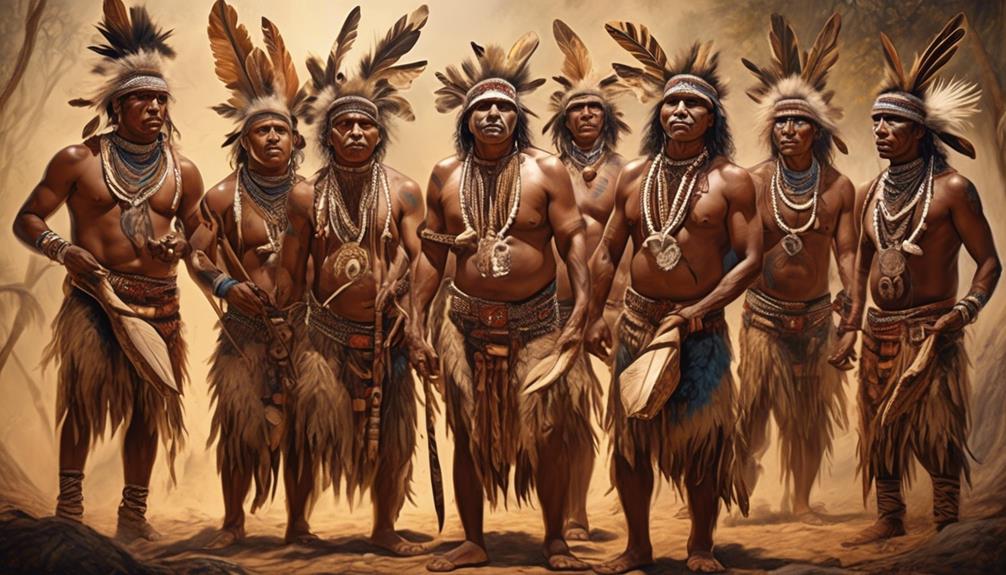
In Aboriginal ceremonial rituals, boomerangs play a significant role, symbolizing tradition and spirituality within the community. The use of boomerangs in these rituals is deeply rooted in the spiritual significance they hold for the Aboriginal people. During ceremonial events, boomerangs are often used as part of traditional dances and performances, where they're wielded with precision and grace, reflecting the interconnectedness of the physical and spiritual realms.
The presence of boomerangs in ceremonial rituals serves to honor the ancestors and connect the community with its heritage. The intricate designs and carvings on the boomerangs often depict stories of creation, ancestral spirits, and the natural world. As they're passed down through generations, these boomerangs become sacred objects, embodying the wisdom and teachings of the past.
Furthermore, the act of throwing and catching boomerangs during these rituals is believed to invoke spiritual energies and blessings. The rhythmic sound of the boomerangs whistling through the air is thought to create a connection between the earthly realm and the spiritual realm, bringing harmony and balance to the community.
Types of Boomerangs Used
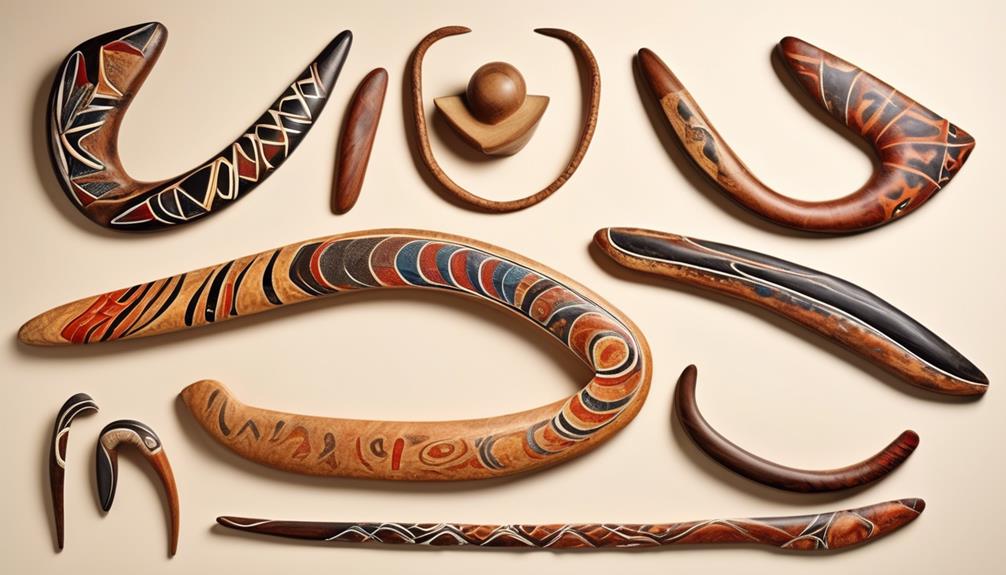
We use different types of boomerangs for various purposes.
Traditional hunting boomerangs are designed for accuracy and distance, while returning boomerangs are crafted to come back to the thrower.
Additionally, there are decorative and ceremonial boomerangs that hold cultural significance and are used in rituals and ceremonies.
Traditional Hunting Tool
Developed over centuries by Aboriginal communities, the types of boomerangs used as traditional hunting tools exhibit a range of shapes and sizes to suit various hunting needs.
These traditional hunting tools include:
- Returning Boomerangs: Designed for small game hunting, these boomerangs are crafted with a curved shape to ensure they return to the thrower.
- Non-returning Boomerangs: These heavier and larger boomerangs are used for larger game hunting, as they don't return when thrown.
- Hooked Boomerangs: Featuring a distinctive hook at one end, these boomerangs are ideal for hunting birds and catching fish.
- Cross Boomerangs: Shaped like a cross, these boomerangs are utilized for hunting multiple targets simultaneously, making them versatile tools in the hands of skilled hunters.
Returning and Non-Returning
Having explored the traditional hunting tools used by Aboriginal communities, the focus now shifts to the specific types of boomerangs, namely the returning and non-returning varieties, and their respective hunting purposes. Returning boomerangs are designed with a unique aerodynamic shape that allows them to return to the thrower when thrown properly. On the other hand, non-returning boomerangs are designed for straight flight and do not return to the thrower. The construction of returning boomerangs involves a more complex shape with asymmetrical wings, while non-returning boomerangs are typically simpler in design, with more symmetrical wings. Here's a comparison of the two types:
| Type of Boomerang | Purpose |
|---|---|
| Returning | Hunting and sport |
| Non-Returning | Hunting and long-distance |
The aerodynamic design and boomerang construction play a crucial role in determining the behavior and purpose of each type.
Decorative and Ceremonial
Used for ceremonial and decorative purposes, boomerangs of this type are often adorned with intricate designs and symbols that hold cultural significance for Aboriginal communities. These boomerangs serve as expressions of decorative art and are imbued with spiritual symbolism.
When used in ceremonies, they carry deep meaning and are often accompanied by traditional songs and dances. The designs on these boomerangs are passed down through generations, each holding a specific story or representing connections to the land and ancestral spirits.
The intricate patterns and symbols reflect the rich cultural heritage of the Aboriginal people and are meticulously crafted with natural pigments and traditional techniques. These ceremonial and decorative boomerangs play a vital role in preserving and celebrating Aboriginal traditions and are valued as sacred cultural artifacts.
Cultural Significance of Boomerangs
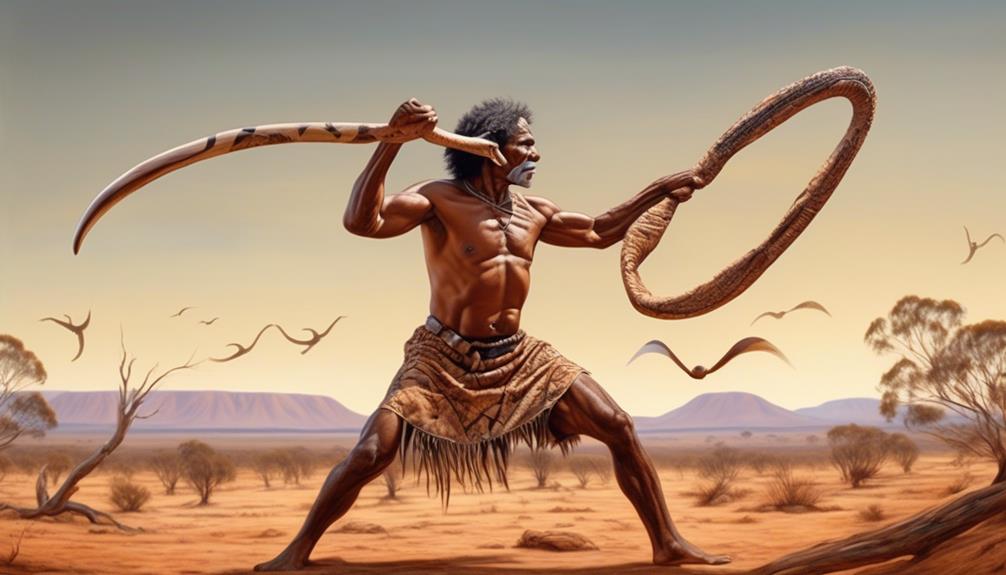
Boomerangs hold deep cultural significance for Aboriginal communities, symbolizing traditional hunting and spiritual practices. The boomerang is not merely a tool; it embodies the artistic craftsmanship and spiritual symbolism that are integral to Aboriginal culture. Its historical evolution and cultural adaptation reflect the rich tapestry of Aboriginal traditions and beliefs.
| Artistic Craftsmanship | Spiritual Symbolism |
|---|---|
| Elaborate designs and carvings showcase the skilled craftsmanship of Aboriginal artisans. | Boomerangs are imbued with spiritual significance, often used in ceremonial rituals and connected to ancestral beliefs. |
| The intricate patterns and engravings on boomerangs reflect the deep connection to the land and the stories of creation passed down through generations. | In some communities, boomerangs are believed to carry the spirits of ancestors, serving as a link between the past, present, and future. |
| The process of creating boomerangs involves traditional techniques that have been preserved and passed down, reinforcing cultural identity and heritage. | Boomerangs are used in spiritual ceremonies and are seen as a means of communicating with the spirit world, invoking protection and guidance. |
| Each boomerang is a unique expression of cultural identity, with distinct symbols and patterns that convey specific meanings and stories. | The shape of the boomerang is often associated with the cycle of life, death, and rebirth, symbolizing the interconnectedness of all living beings. |
The boomerang's significance goes beyond its function as a hunting tool, embodying the essence of Aboriginal culture and spirituality. Its enduring presence in Aboriginal communities reflects the resilience and preservation of indigenous traditions.
Frequently Asked Questions
How Were Boomerangs Traditionally Made by Aboriginal Men?
Boomerang crafting, a practice deeply rooted in Aboriginal techniques, holds immense cultural significance for us. The process involves intricate designs and careful selection of materials, reflecting our spiritual practices.
Traditionally, we crafted boomerangs using wood from specific trees, shaping them to achieve the desired flight pattern. Each step is imbued with cultural meaning and respect for our traditions.
This showcases the deep connection between our craft and spiritual beliefs.
What Role Did Boomerangs Play in Traditional Aboriginal Storytelling and Oral History?
Boomerangs hold a significant role in traditional Aboriginal storytelling and oral history. They're not just tools; they carry symbolic significance and are intertwined with cultural preservation.
Through storytelling, our ancestors passed down knowledge, traditions, and history, ensuring the continuity of our culture. Boomerangs weren't just objects; they were vessels of our oral history, connecting us to our past and preserving our cultural heritage.
Were There Any Specific Rituals or Ceremonies Related to the Crafting or Use of Boomerangs?
Crafting rituals and ceremonial use held significant importance in the Aboriginal culture. The intricate process of crafting boomerangs was often intertwined with spiritual beliefs and traditions, making it a sacred practice.
Similarly, boomerangs were utilized in various ceremonies and rituals, symbolizing connection to the land and ancestral spirits.
The meticulous crafting rituals and ceremonial use of boomerangs reflected the deep reverence and spiritual significance the Aboriginal men placed on these traditional tools.
How Did Different Aboriginal Communities Vary in Their Use and Interpretation of Boomerangs?
Like branches of a mighty tree, different Aboriginal communities varied in their use and interpretation of boomerangs.
The cultural significance of boomerangs differed across regions, influencing hunting techniques and ceremonial practices.
Each community's unique understanding and craftsmanship reflected their deep connection to the land.
The diverse regional differences in boomerang use and interpretation highlight the richness of Aboriginal traditions and the complexity of their relationship with these versatile tools.
What Are Some Modern Adaptations or Uses of Boomerangs Within Contemporary Aboriginal Culture?
In contemporary Aboriginal culture, boomerangs have modern adaptations and hold cultural significance. They're used for practical purposes like hunting and gathering, as well as for artistic expression.
The intricate designs and patterns on boomerangs reflect the rich cultural heritage. These tools aren't only functional but also carry deep symbolic meaning, connecting us to our ancestors and the land.
The contemporary uses of boomerangs continue to showcase their enduring relevance in our culture.
Conclusion
In conclusion, Aboriginal men used boomerangs as hunting tools, in warfare, for recreational activities, and in ceremonial rituals. They utilized different types of boomerangs for various purposes, highlighting the cultural significance of this versatile tool.
Boomerangs weren't just a practical tool, but also held deep spiritual and symbolic meaning within Aboriginal culture. Their use of boomerangs reflected their ingenuity, skill, and deep connection to the land.

